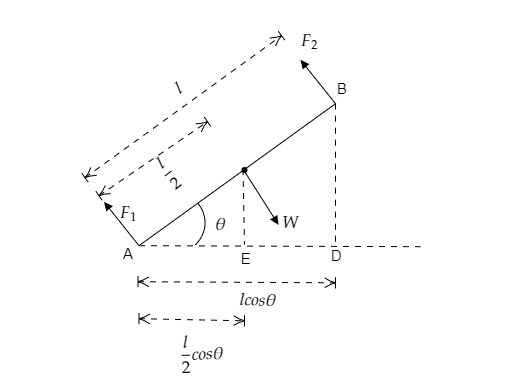
Answer
438.3k+ views
Hint: The heavy bar inclined at some angle with the ground is considered to be in mechanical equilibrium. Then the principle of moments suggests that the sum of the moments of the above system is zero. The net force acting on the given system will also be zero.
Formula used:
The moment of a force is given by, $d \times F = dF$ where $d$ is the perpendicular distance of the action of the force $F$.
Complete step by step answer:

In the above figure, point A corresponds to the end of the bar on the ground and point B corresponds to the end of the bar on the shoulder of the man. AB represents the length of the bar $l$.
Here, the weight experienced by the man is the force ${F_2}$. The corresponding reaction on the ground is ${F_1}$.
Both ${F_1}$ and ${F_2}$ are directed upwards while the weight of the bar $W$ is directed downwards.
The net forces acting on the system can be expressed as ${F_1} + {F_2} = W$ .
The distance AE will be equal to $\dfrac{l}{2}\cos \theta $ and the distance AD represents the horizontal component of the length of the bar i.e., $l\cos \theta $.
Step 2: Use the principle of moments to find the weight experienced by the man.
Here, the weight of the bar $W$ tries to rotate the bar in the clockwise direction while the force ${F_2}$ tries to rotate the bar in the anticlockwise direction.
The principle fo moments gives the sum of the moments as zero.
i.e., ${F_2}\left( {AD} \right) - W\left( {AE} \right) = 0$
$ \Rightarrow {F_2}\left( {AD} \right) = W\left( {AE} \right)$ ------- (1)
Substituting for $AE = \dfrac{l}{2}\cos \theta $ and $AD = l\cos \theta $ in equation (1) we get, ${F_2}\left( {l\cos \theta } \right) = W\left( {\dfrac{l}{2}\cos \theta } \right)$
On simplifying the above expression we get, ${F_2} = \dfrac{W}{2}$
Thus the weight experienced by the man will be ${F_2} = \dfrac{W}{2}$. So the correct option is D.
Note:
The given system is said to be in mechanical equilibrium. This means that it is in a rotational as well as a translational equilibrium. The moment of a force refers to the torque acting. While writing the sum of the moments, the moment in the anticlockwise direction is taken as positive and the moment in the clockwise direction is taken as negative. The center of mass of the system is located in the middle of the bar.
Formula used:
The moment of a force is given by, $d \times F = dF$ where $d$ is the perpendicular distance of the action of the force $F$.
Complete step by step answer:

In the above figure, point A corresponds to the end of the bar on the ground and point B corresponds to the end of the bar on the shoulder of the man. AB represents the length of the bar $l$.
Here, the weight experienced by the man is the force ${F_2}$. The corresponding reaction on the ground is ${F_1}$.
Both ${F_1}$ and ${F_2}$ are directed upwards while the weight of the bar $W$ is directed downwards.
The net forces acting on the system can be expressed as ${F_1} + {F_2} = W$ .
The distance AE will be equal to $\dfrac{l}{2}\cos \theta $ and the distance AD represents the horizontal component of the length of the bar i.e., $l\cos \theta $.
Step 2: Use the principle of moments to find the weight experienced by the man.
Here, the weight of the bar $W$ tries to rotate the bar in the clockwise direction while the force ${F_2}$ tries to rotate the bar in the anticlockwise direction.
The principle fo moments gives the sum of the moments as zero.
i.e., ${F_2}\left( {AD} \right) - W\left( {AE} \right) = 0$
$ \Rightarrow {F_2}\left( {AD} \right) = W\left( {AE} \right)$ ------- (1)
Substituting for $AE = \dfrac{l}{2}\cos \theta $ and $AD = l\cos \theta $ in equation (1) we get, ${F_2}\left( {l\cos \theta } \right) = W\left( {\dfrac{l}{2}\cos \theta } \right)$
On simplifying the above expression we get, ${F_2} = \dfrac{W}{2}$
Thus the weight experienced by the man will be ${F_2} = \dfrac{W}{2}$. So the correct option is D.
Note:
The given system is said to be in mechanical equilibrium. This means that it is in a rotational as well as a translational equilibrium. The moment of a force refers to the torque acting. While writing the sum of the moments, the moment in the anticlockwise direction is taken as positive and the moment in the clockwise direction is taken as negative. The center of mass of the system is located in the middle of the bar.
Recently Updated Pages
How many sigma and pi bonds are present in HCequiv class 11 chemistry CBSE

Mark and label the given geoinformation on the outline class 11 social science CBSE

When people say No pun intended what does that mea class 8 english CBSE

Name the states which share their boundary with Indias class 9 social science CBSE

Give an account of the Northern Plains of India class 9 social science CBSE

Change the following sentences into negative and interrogative class 10 english CBSE

Trending doubts
Difference between Prokaryotic cell and Eukaryotic class 11 biology CBSE

Which are the Top 10 Largest Countries of the World?

Differentiate between homogeneous and heterogeneous class 12 chemistry CBSE

Fill the blanks with the suitable prepositions 1 The class 9 english CBSE

Difference Between Plant Cell and Animal Cell

Give 10 examples for herbs , shrubs , climbers , creepers

The Equation xxx + 2 is Satisfied when x is Equal to Class 10 Maths

Write a letter to the principal requesting him to grant class 10 english CBSE

Change the following sentences into negative and interrogative class 10 english CBSE



